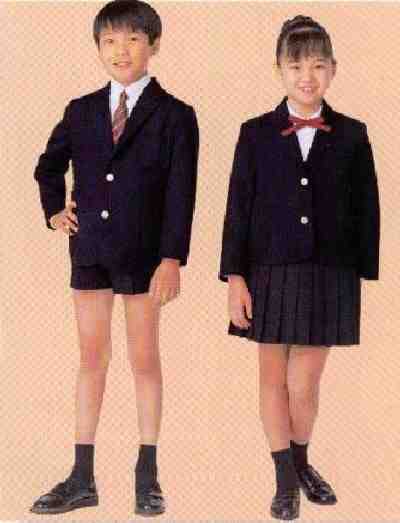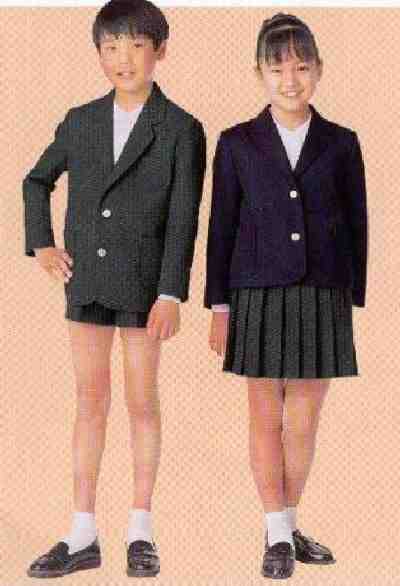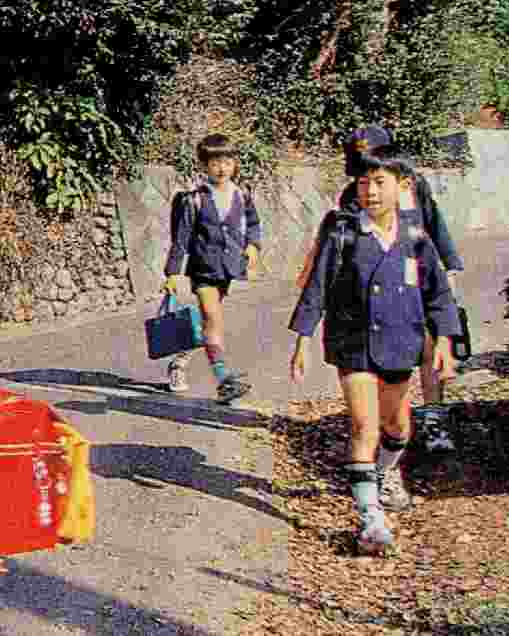
Japanese School Uniform Garments: Blazers

Figure 1.--These elemementary children wear blue blazers for their school uniform. Note that these blazers have lapels. In recent years, ankle socks have become more common than kneesocks. The ties these children wear are not common at Japnese schools, even the schools wear blazers are worn.
|
The blazer as a school garment was introduced to Japan after World War II (1939-45). Blazers are worn at both elementary and secondary schools, although it varies greatly from school to school. Some elementary school although they are most common at private schools. Often the blazers for younger primary school boys are Eton styled blazers without lapels. The blazers worn by secondary school boys more commonly have lapels. School badges on the blazers are not common as in England. Some elementary schools use them only for dress up occasions or for winter wear. Blazers are now becoming more common at secondary schools. Many secondary schools are now replacing the old army and sailor uniforms, which are perceived as old fashion, with blazers, white shirts, and ties--giving a rather British look. Japan is, however, a very tradionally oriented society and the old military styles continue to be widely worn.
Chronology
The blazer as a school garment was introduced to Japan after World War II (1939-45). We do not know of Japanese school children weraring blazers before World War II, bit it is possdible that boys at a few private schools might have worn them. They certainly were no commonly worn.
Type of School
Blazers are worn at both elementary and secondary schools, althogh it varies greatly from school to school.
Elementary school
Most elementary that have uniforms make blazers part of the uniform. Blazers are most common at private schools virtually all of which require uniforms. Many state school have blazers, but do not require the children to wear them for a normal school day, especially during the summer. Private elementary schools, however, do often require that blazers be worn.
Secondary school
Many secondary schools are now replacing the old army and sailor uniforms, which are perceived as old fashion, with blazers, white shirts, and ties--giving a rather British look. Japan is, however, a very tradionally oeiented society and the old military styles continue to be widely worn.

Figure 2.--While blue blazers are by far the most common, some schools also have grey blazers. Brightly colored blazers are unknown.
|
Conventions
Some elementary schools use them only for dress up occasions or for winter wear. Blazers are now becoming more common at secondary schools. Some schools have adopted what they consider a more modern, open look. Blazers are replacing the Prussian styled militatry outfits for boys and the sailor dresses worn by girls. This process, however, is still beginning and these styles are still widely worn.
Colors
Most Japanese school blazers are blue or grey. Blue is especially common. We are not sure why blue has become such a common school color. This was not the case before World War II. At the time school uniforms were the samd color as army uniforms. Perhaps the use of blue is to break with the tradition of the close assocaition between the military and the schools. The colorful blazers once so common in England are virtually unknown in Japan. Blue is by far the most common color, but grey blazers are also worn. Japnese boys all wear patterned suits, but these are suits and not blazers.
Styles
Schools blazers in Japan are generally one of two different styles. Younger boys often where Eton style jaclets, small short jackets with out lapels. We note several of the clothing advertosements shown here show blazers for younger boys with lapels. Older boys usually wear a standad single breasted blazer with lapels and two buttons. The blazers for older boys always have lapels. The blazers commonly have two buttons, although we also notice three-button styles. Japanese boys usually wear their blazers buttoned. I have never noted double breasted school blazers.
Gender
Blazers are worn by both boys and girls. The blazers worn by boys and girls can be the same, altghough often they are identical. Often they look almost the same. Sometimes there are minoe stylistic differences between boys' and girls' blazers.
Seasonality
It can qet quite hot in Japan during the summer. Thus many schools which reqyire uniforms often have both summer and winter uniforms. The summer uniform is usually a simple white shirt worn with short pants, commonly blue short pants. Few state elementary schools requre the children to wear their blazers during the summer.

Figure 3.--The boys at this state elementary school wear Eton lapel-less style blazers and infprmal white shirts without ties. Girls also wear blue jackets, but with Peter Pan collars.
|
Accompanying Clothing
Blazers are commonly worn with caps. Often the younger children wears brightly colored caps. Younger children may wear the same cap style, but older children may wear destinctive boys',and girls' styles. Boys normally wear a white shirt, but ties are not common at state elementary schpps--except on formal occasions. This is quite different from Britain where ties are almost always worn with the blazer is pit on--except for sports. Japanese elementary children very rarely wear ties. Many schools have open-necked shirts. Ties are worn at some private elenentary schools and all secondary schools, except where the Prussian style military uniform is worn. Boys almost always wear short pamts with blazers. Often boys can wear whatever socks they want. Some schools requite white socks. Both ankle and kneesocks are worn.
Age
I am not sure if there are any destinctions for children of different ages at various schools. There often are at British chools, but I am not sure if such destinctions are made at Japamese schools.
Badges
British school children with school uniform blazers, generally have the school badge or emblem on the breasr pocket. This is not common in Japan. We do note, however, a few school that have badges on their breast pockets (figure 3).
Christopher Wagner

Related Chronolgy Pages in the Boys' Historical Web Site
[Main Chronology Page]
[The 1900s]
[The 1910s]
[The 1920s]
[The 1930s]
[The 1940s]
[The 1950s]
[The 1960s]
[The 1970s]
[The 1980s]
[The 1990s]
[The 2000s]
Navigate the Relate Boys Historical Clothing Style Pages
[Main country page]
[Long pants suits]
[Short pants suits]
[Lederhosen]
[Kneesocks]
[Eton suits]
[Jacket and trousers]
[Blazer
[School sandals]
Navigate the Boys' Historical Clothing School Uniform Pages
[Return to the Main Japanese School Uniform garment page]
[Return to the Main School Uniform blazer page]
[Australia]
[England]
[France]
[Germany]
[Ireland]
[Italy]
[Japan] [New Zealand]
[Scotland]
[United States]
Created: March 2, 2000
Last updated: July 20, 2002





